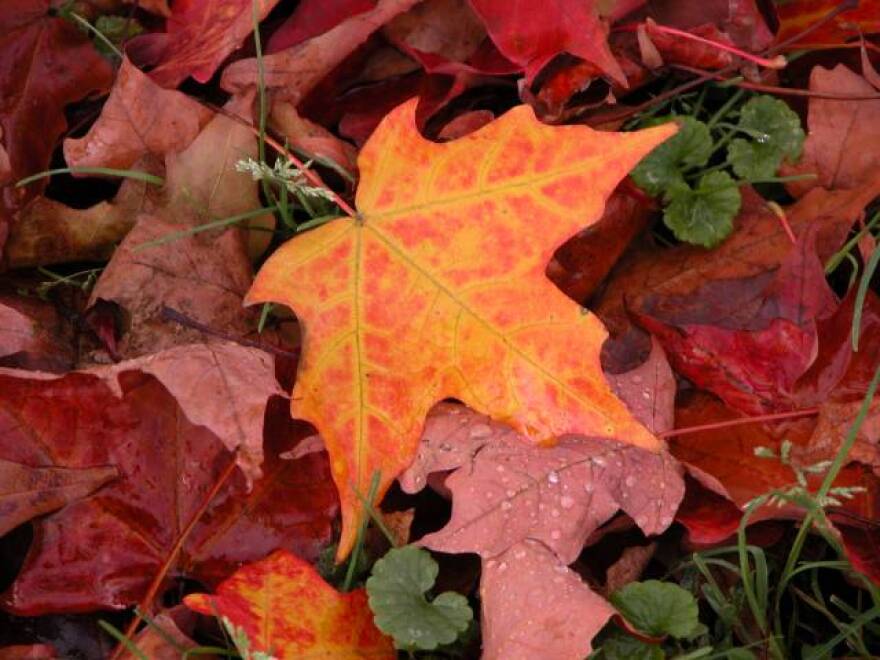Numerous factors influence the vibrance and length of the coming fall foliage season. Among them are the amount of rain and what types of stresses the trees have been exposed to over the course of the growing season. In Vermont a range of colors are anticipated each year from the deep reds and rusty oranges produced by maple and oak trees to the yellow leaves of Alder and beech trees.
Vermont Commissioner of the Department of Forests, Parks and Recreation Michael Snyder is also the state forester. He tells WAMC North Country Bureau Chief Pat Bradley the foliage outlook this year is good despite drought conditions in some areas that may stress trees.
By and large, the trees have done their part growing all summer and doing their thing and now responding to shortening day lengths and kind of making preparations if you will, for winter and physiological changes that result in this brilliant display of colors. So, you know, the normal factors of healthy growth during the growing season, and that requires ample moisture and good sunshine and minimum of pests and pathogens. And so that's largely been the case this year. But we've had a little more of some of those other things. So drought in Vermont. Pretty much the entire state is either categorized now as being either in moderate drought or abnormally dry with one small area in southeastern Vermont technically ranked as severe drought. So severe drought is a real problem for trees that tends to make leaves turn brown. They get scorched. If they're going to turn colors, they might do it early and then drop completely. So severe drought, which does exist in some parts of Vermont and elsewhere in the region, will result in pockets of poor foliage coloration. That said, abnormally dry and moderate drought conditions can actually enhance color development in certain cases. And so we've noticed that for some years now and least in Vermont, given that much of the state is in those lesser categories of drought stress, we're still hopeful that they will be able to put on the traditional spray of amazing color.
Why does the abnormal dry conditions actually enhance the color? You would think that it would be stressing the tree.
Quick explanation of the science of fall foliage and then maybe I can answer your question a little better. If I start with they green all summer because of this very important pigment called chlorophyll. And as the days get shorter, the trees clue into that and trigger the beginning of some changes which is they stop making chlorophyll. And then they start to recycling some of those constituent chemicals they use to make chlorophyll molecules. And that's why we start to see the trees go from green and then as it breaks down further you start to see some yellows and in the most stressed trees some reds developing. The red pigments they play a role, kind of a protective role, in this transition time. And so under stress, like the drought stress, it can enhance the development of those kind of protective pigments. And again as a byproduct we get to see the nice colors.
Do these responses vary dramatically between different species of trees?
Yes and even within trees within a species. You know one sugar maple to the next can be seen somewhat different. You know, we have a greater variety of tree species and a greater variety of conditions that results in a greater variety of coloration. And so it does vary. We are heavy to maples. One and four trees in Vermont is a maple of some sort: sugar maple, red maple, and they're kind of the show stealers. But you know, there's so many others you referenced birch, beech and you know, oaks and they all do it somewhat differently, do it at different times and they respond to stresses slightly differently. I think that's what adds to New England's and particularly Vermont's intensity and variety of colors that we have this variety of soil conditions that translates into a variety of tree types. And that variety really translates into and explains in a big way, why ours is just the world's best fall foliage.
If somebody wants to come to Vermont during fall foliage season this year what kind of route would you send them on? What should they expect from the trees?
It's very early but it has begun, its annual display, and it begins kind of slowly with the odd red splash on a hillside somewhere of a sentinel tree sort of signaling what's to come and right now we're seeing earliest color in the northeastern part of the state, the Northeast Kingdom and along the spine of the Green Mountains. And then we can expect that to progress downslope into the Connecticut Valley to the east and the Champlain Valley to the west and then downstate as we proceed. But that's really the story is north - south, upper elevations to lower elevations. And if the last several years are any indication, full colors throughout the state for the first couple weeks of October.
Commissioner Michael Snyder and foresters from the Department of Forest, Parks and Recreation provide a weekly update on foliage conditions.



